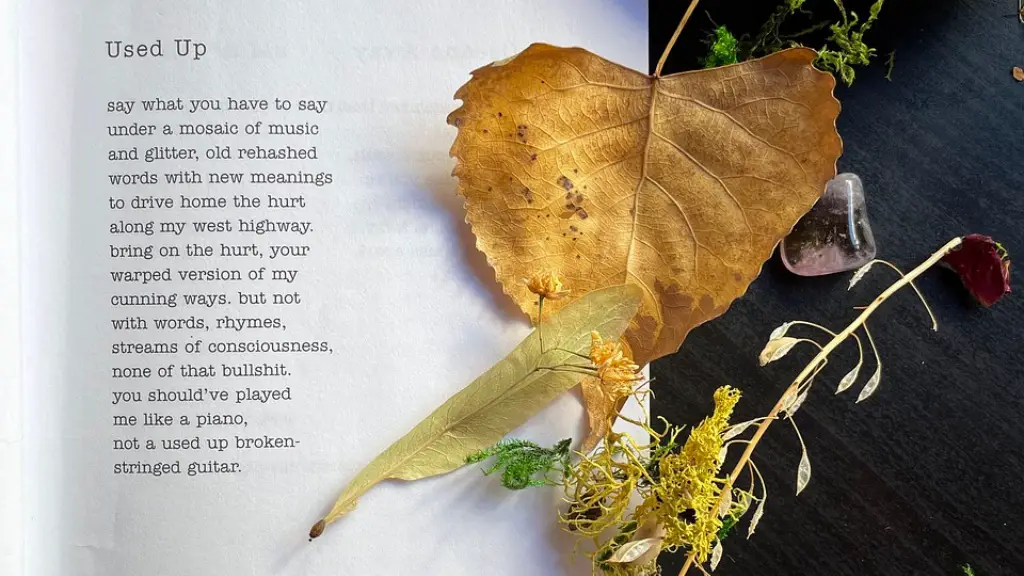How to Praise Poetry
Praise poetry can be a powerful way to articulate emotions, express creativity and share experiences. Understanding the different ways of praising poetry can help to elevate the creative talent of a poet and make the poem stand out from the crowd. Knowing how to properly praise poetry not only demonstrates an appreciation of the poet’s work but also broadens one’s own understanding of the poem.
There are many ways to praise a poem without it sounding like a generic compliment. Here are some creative ways to express appreciation for a poem that captures its true beauty.
Brief Summary
Sharing a brief summary of the poem can be a great way to praise its content. A concise summary keeps the reader engaged by highlighting the poem’s main ideas, concepts, and values. Additionally, this provides a strong context for the poem and helps the reader to understand the poet’s work better. When summarizing a poem, focus on the title, last line, and the poem’s inner subtleties.
Describe Visuals
Describing the visuals in a poem can be another powerful way to show admiration. Visuals can be powerful tools in a poem, and praising them specifically can demonstrate how skillfully the visuals are intertwined with the poem’s overall message and purpose. By praising the visuals of a poem, the reader can gain a better appreciation for the poet’s skill in combining visuals and words to create an atmospheric experience.
Analyze Metaphors
Analyzing the metaphors within a poem can be one of the best ways to assess its beauty. A metaphor is an expression that compares two things in order to draw a deeper meaning from them. Understanding the hidden messages within a poem’s metaphors can demonstrate not only the poet’s ingenuity but also the poem’s true beauty. By analyzing and praising the metaphors within a poem, the reader can express admiration in a more profound way.
Discuss Feelings
Discussing the feelings the poem evoked can be a great way to express appreciation. Talk about how the poem made you feel and how it resonated with your personal experience to help the reader understand the poem better. This will not only help the reader appreciate the poem further but may also spark a meaningful discussion.
Compare to Other Poems
Comparing a poem to other similar poems can be an excellent way to praise its content and structure. Discuss what makes it unique, what inspired you and where it fits within the broader context of poetry. Comparing the poem to others of a similar style and structure can help the reader form an appreciation of the overall poem and its unique qualities.
Point Out Rhetorical Devices
Pointing out the rhetorical devices used in the poem can be another way to appreciate its beauty and power. These can include alliteration, irony, personification, and synecdoche. Rhetorical devices are powerful tools that are used to elevate a poem’s overall message and to express emotions more effectively. By pointing out these devices, the reader can identify how expertly they are woven among the poem’s content.
Word Choice and Rhyme Scheme
Discussing the poet’s word choice and rhyme scheme can be a great way to express admiration. Praise the poet’s skill in finding the right words to effectively express the poem’s purpose and how they were woven into an artwork. Additionally, talk about the poet’s skill in finding the right words to form a meaningful rhyme scheme that enhances the poem’s overall flow.
Style and Form
The style and form of a poem can be key elements in its overall beauty. Praise the poem’s structure and discuss how the style, form, and imagery work together to create a powerful atmosphere. This can help the reader to understand the poem’s overall message in more depth and appreciate the poet’s skill in combining words and structure.
Review Structure
Conducting a review of the poem’s structure can be a great way to assess its beauty. Analyze the poem’s introduction, argument, and conclusion, and discuss how the poem’s content works together to effectively express its overall message. This will help the reader understand the poem better and gain an appreciation for the poet’s skill in crafting a meaningful and powerful poem.
Understand the Context
Understanding the poet’s context and their inspiration for creating the poem can help to further appreciate the poem’s content. Investigate the poet’s history, their personal story and the events that may have inspired them to write the poem. This will provide a more detailed insight into the poem and allow the reader to appreciate the poem’s content even more.
Examine Its Themes
Examining the poem’s themes can be a great way to assess its beauty. Identify the poem’s main themes and discuss how they are intertwined with the poem’s other elements. Discuss how the themes are presented and why they are important to the poem’s overall message. This will broaden the reader’s understanding of the poem and help them to appreciate its nuanced beauty.
Explore Classic Elements
Exploring the poem’s classic elements can provide an opportunity to understand and appreciate its beauty. Analyze the use of imagery, structure, language and other classic elements of a poem. This will shed light on the poetic devices used in great poems and demonstrate an appreciation for the poem’s craft and execution.
Engage With the Poet
Engaging with the poet can be a great way to gain an insight into their work and truly appreciate their poem. Contact the poet directly to ask questions about the poem and to understand what inspired them to create it. Engaging with the poet can provide a better context for their work and can deepen the appreciation of the poem.
Sharing the poem with your friends, family and other readers is another great way to praise the poem. Posting your appreciation for the poem on social media will show your followers and other poets how much you appreciate the poem. This will help to encourage dialogue around the poem and can inspire others to create their own powerful poems.
Encourage Others to Read it
Encouraging others to read a poem is another great way to demonstrate appreciation. Suggest the poem to friends and family and explain why the poem is important and should be read by a larger audience. Additionally, sharing or recommending the poem to those in a similar field will help to increase its reach and appreciation.
Provide Constructive Criticism
Providing constructive criticism can also be a good way to praise a poem. Discuss the poem’s strengths and weaknesses and how it could be improved. This will not only encourage dialogue between the poet and readers but also provide constructive feedback that can help to improve the poem. By noting the poem’s strengths and weaknesses, the reader can commend the poet in a more meaningful way.




